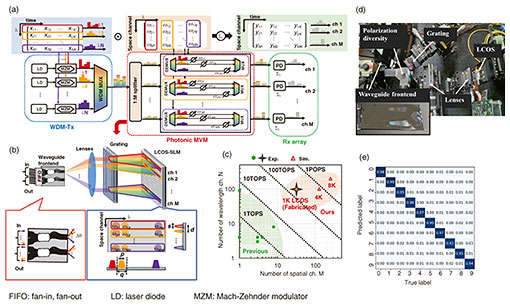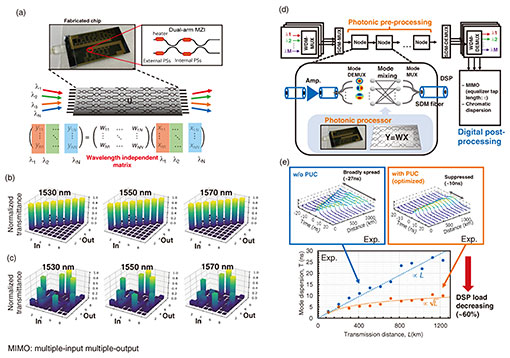 |
|||||||||||||||||||||||||
|
|
|||||||||||||||||||||||||
|
Regular Articles Vol. 23, No. 11, pp. 79–85, Nov. 2025. https://doi.org/10.53829/ntr202511ra1 Space and Wavelength Multiplexed Programmable Photonic ProcessorsAbstractPhotonic computing based on programmable photonic processors is raising interest as it promises massively parallelized computation with low energy consumption for tensor processing in machine learning by harnessing inherent parallelism of light. In this article, we describe our recent progress in scaling up photonic computing platforms, including our development of a large-scale photonic matrix-vector processor and on-chip photonic linear processor. We experimentally demonstrate the applications of our processors to a machine-learning accelerator and pre-processor for optical communications. Keywords: photonic computing, machine learning, reservoir computing, optical communications 1. IntroductionThe astonishing advancement in machine learning based on deep neural networks (DNNs) has shown its effectiveness in a wide range of applications such as image generation, machine translation, and physical simulation [1]. This rapid advancement raised critical issues regarding the energy consumption of such computations. For example, large language models require approximately 1025 computations, which consume hundreds of megawatts of energy and emit large amounts of carbon dioxide [2, 3]. These issues have motivated research to achieve more efficient computations on alternative analog hardware using various physical platforms by considering the analogy between the physical laws and computation of the neural network models. Programmable photonic processors have been intensively studied since they promise massively parallelized computation with low energy consumption for tensor processing in machine learning [4]. The inherent parallelism of light in space, frequency, and time divisions enables parallel and wide-bandwidth processing, which significantly reduces latency and energy consumption compared with electronic processors. A photonic processor would be a promising alternative for machine learning and telecommunications where the bottleneck is the linear processing of its electronic counterparts. In this article, we describe our progress in photonic processors and their application to machine learning and optical communications, as shown in Fig. 1 [5–12].
2. Large-scale photonic tensor processor with hybrid waveguide and free-space opticsPhotonic matrix-vector multiplication (MVM) based on linear optics is a fundamental component of photonic analog machine learning. A common implementation is wavelength division multiplexing (WDM)-defined tensor processing, as shown in Fig. 2(a). The processor is composed of a WDM-transmitter (Tx), photonic MVM device, and receiver (Rx) array. In this scheme, the N input WDM signals are split into M branches, which are dispersed with a WDM demultiplexer (DMUX) and weighted with variable optical attenuators independently. They are then multiplexed with a WDM multiplexer (MUX) and detected with photodetectors (PDs). The operations per second (OPS) of this configuration can be estimated from the following equation: OPS=2NMB, where N is the number of WDM channels and B is the baud rate of the signal. Thus, the scalability is equal to the M×N value of the photonic MVM device. We developed a scalable photonic MVM device using a hybrid waveguide and free-space optics technology [5, 6]. Figure 2(b) shows a simplified schematic of the architecture of our MVM device. With this device, we can independently control densely multiplexed WDM signals by controlling the wavefront of each beam with a liquid-crystal-on-silicon (LCOS) spatial light modulator (SLM). Figure 2(c) shows the scalability of our MVM device. We constructed an optical benchtop (Fig. 2(d)) supporting M=32 and N=100 as a demonstration, which can be considered to achieve a computation speed of 188 tera OPS (TOPS) by assuming B=30 Gbaud. For the computation benchmark, we executed convolution processing in a convolutional neural network (CNN). We obtained 95.8% accuracy in a handwritten digit recognition task on the Modified National Institute of Standards and Technology (MNIST) dataset (Fig. 2(e)), suggesting successful operation of our device.
3. WDM-compatible MZI mesh for telecom applicationA Mach-Zehnder interferometer (MZI) mesh is another promising candidate for a matrix operation engine [7, 8]. It can execute MVM for each wavelength channel on the basis of spatial parallelism. Thus, multiple MVMs, which correspond to the matrix-matrix multiplication (MMM) used for tensor processing in machine-learning-specific hardware, can be executed at one time by inputting the WDM signal when the weights on the MZI mesh are insensitive to changes in wavelength. We used our silica-based photonic platform technology, called a planar lightwave circuit (PLC) [9], to integrate a wideband MZI mesh [5]. Figure 3(a) shows a photograph of a mesh-type 8×8 integrated photonic processor. Figures 3(b) and (c) show the measured transmitted identity and random matrices for 1530, 1550, and 1570 nm. The results suggest that the photonic processor can compose the same matrices over the examined spectral region. The achievable computation speed is estimated to be >128 TOPS, assuming >10-Gbaud operation with 100 wavelength channels. A significant use case of the photonic processor in optical communications is as a photonic pre-processor installed in each optical node to reduce the load of the digital signal processor (DSP) [8, 9]. We demonstrated mode-permutation optimization by using an on-chip photonic MZI mesh for long-haul spatial division multiplexed (SDM) transmission (Fig. 3(d)). Our integrated photonic unitary converter (PUC) provided seamless switching capability between weak to strong mode-coupling regimes, which suppresses modal dispersion by controlling the modal mixing state. By optimizing the parameters in the PUC, we achieved 1331-km three-mode transmissions while reducing the equalizer length (Fig. 3(e)).
4. Space/wavelength/time multiplexed photonic reservoir computer on chipsOn the basis of the above-described MVM functions, we can implement neural network operations beyond simple linear algebra into photonic circuits. We demonstrated an on-chip photonic reservoir computer (RC) integrated with our PLC [10]. In the RC framework, only the output weights are trained while the optical weights are set randomly. Thus, there is no need for any fine tuning of the optical system during training. As the training time is determined by forward propagation in the RC, it can be accelerated using photonics. In spite of the simple training, photonic RCs have performed well in a series of benchmark tasks, such as speech and image recognition. Figure 4 shows a schematic of our photonic RC. In contrast to previous on-chip implementations of the RC, both the input and reservoir weights are optically encoded in the spatiotemporal domain, which enables scalable integration on a compact chip. Although the nonlinear activation functions are only implemented in the input and output, the complex-valued evolution in coherent systems ensures rich dynamics comparable to that of incoherent nonlinear systems. Our photonic RC supports parallel processing on the basis of WDM, which enables the use of an extremely wide optical bandwidth (>THz) as a computational resource. Experiments with standard benchmarks showed good performance for chaotic time-series forecasting and image classification with extremely fast processing speeds (e.g. 17.1 ns for 28×28 image classification). The photonic RC can execute 21.12 tera multiplication–accumulation OPS (MAC¡¦s-1) for each wavelength and reach petascale computation speeds on a single photonic chip by using WDM parallelism. Signal processing for optical communications, such as nonlinear equalization, signal format identification, and phase retrieval, have been demonstrated for practical applications using a photonic RC scheme.
5. Gradient-free training for photonic neural networksWhile photonic neural networks mimic analog information processing of the brain, the learning procedure still relies on methods optimized for digital processing because of the difficulty in achieving a photonic implementation of a standard training algorithm such as backpropagation (BP), which otherwise limits the application of photonic processing to the training stage. We previously proposed BP-free photonic deep-learning method [11, 12] that involves using a biologically inspired training algorithm called augmented direct feedback alignment (a-DFA). Figure 5(a) compares the BP, DFA, and our a-DFA algorithms. Our a-DFA algorithm uses fixed random linear transformations of the error signal at the final output layer instead of the backward error signals used with the BP and DFA algorithms. We replace the differential of the physical nonlinear activation ƒ’(a) with an arbitrary nonlinearity g(a). For example, for a standard multilayer perceptron (MLP) network [described as x(l+1) = ƒ(a(l)), where a(l) = W(l)x(l) with weight W(l) and input x(l) for the lth layer], we can estimate the error for each layer e(l) as follows: e(l) = [B(l) e(L)] ⨀ g(a(l)), where B(l) is a random projection matrix for the lth layer. From e(l), we can compute the gradient for each W(l) as δW(l) = ¡Ýe(l)x(l),T. Thus, we can update the network from the final error e(L) and alternative random nonlinear projection of the given a(l), which no longer requires knowledge of the original networks. We can also execute such a random nonlinear projection on a scalable photonic engine. Although we only described a simple MLP model case above, our photonic deep-learning method is scalable to modern networks (e.g. MLP-mixer, ResNet, and Transformer) and photonic-hardware-familiar networks (e.g. spiking neural networks and RCs). As a demonstration, Fig. 5(b) summarizes the test accuracies of each model trained using the a-DFA and BP (baseline) algorithms in a numerical simulation using the MNIST dataset. We also experimentally confirmed the effectiveness of the a-DFA training on our photonic RC shown in Fig. 5(c). The competitive performance of our biologically inspired deep-learning method on the benchmarks (Fig. 5(d)) shows its potential for accelerated computation.
6. SummaryWe reported our progress in scaling up photonic computing platforms. Thanks to the dense parallelization of both space and wavelength divisions, our photonic processor for matrix multiplications can reach computational speeds on sub-petascale OPS. We also described an on-chip integration of a photonic recurrent neural network, called an RC, and a gradient-free machine-learning algorithm for the analog photonic hardware that uses our biologically inspired training method. References
|
|||||||||||||||||||||||||















